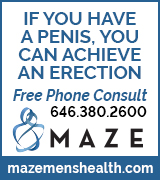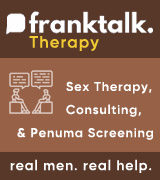Renal & Urology News
August 28, 2012
Shock Waves Successfully Treat Erectile Dysfunction
CHICAGO—Low-intensity shock wave therapy (LI-ESWT) to the penis can effectively treat vasculogenic erectile dysfunction (ED), according to a new study.
The treatment was associated with significant improvements in erectile function as measured using the International Index of Erectile Function-Erectile Dysfunction (IIEF-ED) questionnaire and significant improvements in penile hemodynamic parameters, investigator Yoram Vardi, MD, of Rambam Medical Center in Israel, reported at the World Meeting on Sexual Medicine.
The study included 60 men with vasculogenic ED who had responded to phosphodiesterase-5 (PDE-5) inhibitors. Subjects had a mean age of 56.5 years and at screening had an IIEF-ED score of 19 or higher with PDE-5 inhibitor use. After a one-month washout, the men underwent a baseline assessment of erectile function using the IIEF-ED questionnaire and objective local endothelial function testing using penile flow mediated dilatation (FMD). In a blinded fashion, researchers randomly assigned men to receive either LI-ESWT or a sham treatment.
The average IIEF-ED score at baseline was 12.3 (without PDE-5), with no statistically significant difference between the treatment and sham groups.
The treatment protocol included 12 sessions of LI-ESWT twice weekly for three weeks, repeated after a three-week no-treatment interval. No PDE-5 inhibitor was permitted during the study. Erectile function was re-evaluated one month after treatment. For subjects who did not respond sufficiently to the treatment (defined as an increase in IIEF-ED score of less than five points), an additional 12 session shock wave treatment was offered.
The average increase in IIEF-ED score between baseline and one month post treatment follow up was 6.7 for the treatment group compared with 2.9 for the sham group. In addition, 65% of the treated group had a five-point increase or greater in IIEF-ED score compared with only 25% of the sham group. The differences between the groups were statistically significant.
FMD tests showed that all penile hemodynamic parameters increased significantly only in the treatment group. No adverse events were reported. All other evaluated parameters showed similar results. Of 23 subjects who underwent a second shock wave treatment, 16 (80%) were from the sham group. One month after the end of the second treatment session, the IIEF-ED score of these 16 patients increased significantly from an average of 11.8 to 16.6.
The meeting is cosponsored by the International Society for Sexual Medicine and Sexual Medicine Society of North America.
?New Treatment?
-
hoosierphilly
- Posts: 132
- Joined: Mon Mar 14, 2011 11:08 am
Re: ?New Treatment? continued
I plan to see if the Alpha-Stim (from Texas) will aid my ED! I have stents (not in the penis), and Type 2 diabetes, and ED recently if performance with discomfort????
Any thoughts out there.
Shock waves may improve penile vasculature.
LYON, FRANCE—Israeli researchers have reported promising preliminary results using low-intensity shock wave therapy to treat vasculogenic erectile dysfunction (ED).
In fact, 15 of 20 patients with mild or moderate ED who have been treated thus far had a significant improvement in erectile function and in most cases were able to discontinue treatment with phosphodiesterase-5 (PDE-5) inhibitors. There were no reports of pain or other adverse effects.
Yoram Vardi, MD, chief of the neuro-urology unit at Rambam Medical Center in Haifa, presented the findings here at the annual meeting of the European Society for Sexual Medicine.
Low-energy shock wave therapy is being increasingly used to induce regeneration of small coronary vessels in patients with angina who are not suitable for coronary surgery or angioplasty, Dr. Vardi explained.
His group had hypothesized that if the therapy can improve the vasculature of the heart, it might also be effective in the penis because 80% of ED cases are of vascular origin.
Participants in the trial had a score of 12 to 20 on the Erectile Function domain of the International Index of Erectile Function (IIEF-ED) and abnormal nocturnal penile tumescence (NPT). In all cases, ED had a vascular origin. The mean duration of ED was 35 months.
During each treatment session, low-energy shock wave therapy was applied on the penile shaft and crus for three minutes in each of five anatomical sites. The shock waves were are one-tenth the level of intensity as the shock waves used to pulverize kidney stones.
The men underwent a three-week course of two weekly treatment sessions and a second identical round of therapy starting three weeks later. Erectile function was assessed at the time of enrollment and four weeks after the end of treatment.
“The protocol used to enhance vasculogenesis of the ischemic heart is the same one we used to treat ED,” Dr. Vardi said.
Results showed that the IIEF-ED score improved by more than five points in 15 patients (75%). Seven of 20 patients (35%) had an improvement of more than 10 points.
Six-month follow-up data show that 12 of the 15 patients who improved significantly with treatment said they no longer needed to use PDE-5 inhibitors to treat their condition.
Scores on several other validated ED questionnaires including Quality of Erection Questionnaire, Self-Esteem and Relationship Questionnaire, and Erectile Dysfunction Inventory of Treatment Satisfaction also improved significantly.
The analysis additionally showed a significant improvement in baseline and maximal flow values on a penile endothelial function test.
“We are very excited by our findings but it's important to emphasize that they are preliminary and that further evaluation is needed using sham control and long-term follow-up,” Dr. Vardi said. “And what has been especially gratifying is that patients have told us that they are very pleased with the results and they tell us that they are again having morning erections and that they can perform better.”
From the January 2010 Issue of Renal And Urology News »
This coverage is not sanctioned by, nor a part of, the European Association of Urology.
Medscape Medical News
Penile Shock Wave Therapy Helps Men With Severe Erectile Dysfunction
Jill Stein
March 22, 2011
Editors' Recommendations
•Phosphodiesterase Inhibitors in Clinical Urology
•Assessing Satisfaction in Men and Their Female Partners After Treatment With Phosphodiesterase Type 5 Inhibitors for Erectile Dysfunction
•Zotarolimus-Eluting Peripheral Stents for the Treatment of Erectile Dysfunction in Subjects With Suboptimal Response to Phosphodiesterase-5 Inhibitors
Receive an email from Medscape whenever new articles on this topic are available.
•Personal Alert Add Erectile Dysfunction to My Topic Alert
Medscape on your selected topics.
March 22, 2011 (Vienna, Austria) — Low-intensity shock wave therapy to the penis can help men with severe erectile dysfunction (ED) that is unresponsive to conventional phosphodiesterase type 5 (PDE-5) inhibitor treatment, according to data released here at the European Association of Urology 26th Annual Congress.
"Our earlier randomized double-blind placebo-controlled study demonstrated that low-intensity shock wave therapy can help men who respond to PDE-5 inhibitor therapy, and our new data show that the treatment is also beneficial when given to nonresponders with severe ED," Yoram Vardi, MD, head of the neuro-urology unit at Rambam Medical Center in Haifa, Israel, told Medscape Medical News.
Dr. Yoram Vardi
The new findings confirm that the treatment exerts a genuine physiological effect on the erectile mechanism when applied directly to the cavernosal tissue, he added.
Dr. Vardi reported results in 29 men with vasculogenic ED who had a mean baseline International Index of Erectile Function (IIEF-ED) domain score of 8.8 and a rigidity score of 2 or lower. Their mean age was 62.8 years.
"While the introduction of PDE-5 inhibitors undeniably represents a major advance in ED treatment, these agents are a symptomatic treatment and are associated with unpleasant side effects and poor compliance," Dr. Vardi said. "These limitations become magnified when the treatment is intended for a pleasurable biological function rather than a life-threatening disease."
Rationale for Shock Wave Therapy in ED
Low-energy shock wave therapy is being increasingly used to induce the regeneration of small coronary vessels in patients with angina who are not suitable for coronary surgery or angioplasty, Dr. Vardi explained.
If the therapy can improve the vasculature of the heart, it might also be effective in the penis, because 80% of ED cases have a vascular origin, he said.
The shock wave therapy protocol involved 2 treatment sessions per week for 3 weeks, which were then repeated 3 weeks later.
During each treatment session, low-energy shock wave therapy was applied to the penile shaft and crus for 3 minutes in 5 different penile anatomical sites. The shock waves are one tenth the level of intensity as shock waves used to pulverize kidney stones.
Patients had a follow-up assessment at 1 month, when they were not receiving a PDE-5 inhibitor, and again at 2 months, when they were receiving active on-demand PDE-5 inhibitor therapy.
The coprimary end points were changes on the IIEF-ED domain score and penile rigidity score.
Significant Improvement
At the end of the study, 21 patients (72.4%; P < .0001) achieved a rigidity score of 3 or higher, meaning they were able to achieve full vaginal penetration.
The mean IIEF-ED domain score of the participants increased to 18.8 ± 1.1 (P < .0001). For 22 patients (75.9%), the IIEF-ED domain scores were increased by 5 or more points, and the average improvement for all 30 patients exceeded 10 points. The erectile function of 8 patients had normalized at the second follow-up visit, and patients were able to function sexually without the use of medication.
In addition, all 3 hemodynamic penile parameters (maximum flow-mediated dilation [FMD]) and area under the curve FMD significantly increased (P = .0001) and were significantly associated with an increase in IIEF-ED domain scores (P < .05).
There were no complaints of pain related to treatment, and no adverse events were reported during follow-up.
"The findings mean that low-intensity shock wave therapy was able to convert most nonresponders into PDE-5 inhibitor responders, thereby enabling men who were not functioning sexually to now achieve vaginal penetration and full intercourse," Dr. Vardi observed.
Importantly, the 21 diabetic patients in this series had significant improvement in ED. "These men are normally very difficult to treat," he said.
Elsewhere at the meeting, Dr. Vardi reported that the results from the first randomized sham-controlled study demonstrated that the application of the device directly to the penis has a significant effect on erectile mechanism and hemodynamics, compared with the sham intervention.
Ther Adv Urol. 2013 Apr;5(2):95-9. doi: 10.1177/1756287212470696.
Shockwave treatment of erectile dysfunction. from pubmed.gov
Gruenwald I, Appel B, Kitrey ND, Vardi Y.
Author information
•Neuro-Urology Unit, Rambam Medical Center and Rappaport Faculty of Medicine, Technion, Haifa 34679, Israel.
Abstract
Low-intensity extracorporeal shock wave therapy (LI-ESWT) is a novel modality that has recently been developed for treating erectile dysfunction (ED). Unlike other current treatment options for ED, all of which are palliative in nature, LI-ESWT is unique in that it aims to restore the erectile mechanism in order to enable natural or spontaneous erections. Results from basic science experiments have provided evidence that LI-ESWT induces cellular microtrauma, which in turn stimulates the release of angiogenic factors and the subsequent neovascularization of the treated tissue. Extracorporeal shock wave therapy (ESWT) has been clinically investigated and applied in several medical fields with various degrees of success. High-intensity shock wave therapy is used for lithotripsy because of its focused mechanical destructive nature, and medium-intensity shock waves have been shown to have anti-inflammatory properties and are used for treating a wide array of orthopedic conditions, such as non-union fractures, tendonitis, and bursitis. In contrast, LI-ESWT has angiogenetic properties and is therefore used in the management of chronic wounds, peripheral neuropathy, and in cardiac neovascularization. As a result of these characteristics we initiated a series of experiments evaluating the effect of LI-ESWT on the cavernosal tissue of patients with vasculogenic ED. The results of our studies, which also included a double-blind randomized control trial, confirm that LI-ESWT generates a significant clinical improvement of erectile function and a significant improvement in penile hemodynamics without any adverse effects. Although further extensive research is needed, LI-ESWT may create a new standard of care for men with vasculogenic ED.
KEYWORDS:
erectile dysfunction, male impotence, shockwaves, therapy
PMID:23554844[PubMed] PMCID:PMC3607492Free PMC Article
Dr. James Catto
"The biggest problem with ED treatments is that the tablets are used on an on-demand basis and don't work for a proportion of patients; that proportion may be 30% or 70%, depending on the population and the prescribing physician," James Catto, MB ChB, PhD, FRCP, from the academic urology unit and Institute for Cancer Studies at the University of Sheffield, United Kingdom, told Medscape Medical News. "If tablets don't work, we consider options like injections and pumps, which are much less palatable for the patient and his partner."
The potential appeal of shock wave therapy is that, unlike current ED treatments, which are symptomatic and used on an on-demand basis, shock wave therapy aims to provide sustained improvement of the erectile mechanism and cure ED, he said. "Shock wave therapy potentially allows a man to return to a more normal environment, where he doesn't have to use medication. If he does still use medication, he will likely get a better result from it."
The study was partially supported by an unrestricted grant from Medispec, the company that manufactures the ED1000 device that was used in the study. Dr. Vardi and Dr. Catto have disclosed no relevant financial relationships.
Any thoughts out there.
Shock waves may improve penile vasculature.
LYON, FRANCE—Israeli researchers have reported promising preliminary results using low-intensity shock wave therapy to treat vasculogenic erectile dysfunction (ED).
In fact, 15 of 20 patients with mild or moderate ED who have been treated thus far had a significant improvement in erectile function and in most cases were able to discontinue treatment with phosphodiesterase-5 (PDE-5) inhibitors. There were no reports of pain or other adverse effects.
Yoram Vardi, MD, chief of the neuro-urology unit at Rambam Medical Center in Haifa, presented the findings here at the annual meeting of the European Society for Sexual Medicine.
Low-energy shock wave therapy is being increasingly used to induce regeneration of small coronary vessels in patients with angina who are not suitable for coronary surgery or angioplasty, Dr. Vardi explained.
His group had hypothesized that if the therapy can improve the vasculature of the heart, it might also be effective in the penis because 80% of ED cases are of vascular origin.
Participants in the trial had a score of 12 to 20 on the Erectile Function domain of the International Index of Erectile Function (IIEF-ED) and abnormal nocturnal penile tumescence (NPT). In all cases, ED had a vascular origin. The mean duration of ED was 35 months.
During each treatment session, low-energy shock wave therapy was applied on the penile shaft and crus for three minutes in each of five anatomical sites. The shock waves were are one-tenth the level of intensity as the shock waves used to pulverize kidney stones.
The men underwent a three-week course of two weekly treatment sessions and a second identical round of therapy starting three weeks later. Erectile function was assessed at the time of enrollment and four weeks after the end of treatment.
“The protocol used to enhance vasculogenesis of the ischemic heart is the same one we used to treat ED,” Dr. Vardi said.
Results showed that the IIEF-ED score improved by more than five points in 15 patients (75%). Seven of 20 patients (35%) had an improvement of more than 10 points.
Six-month follow-up data show that 12 of the 15 patients who improved significantly with treatment said they no longer needed to use PDE-5 inhibitors to treat their condition.
Scores on several other validated ED questionnaires including Quality of Erection Questionnaire, Self-Esteem and Relationship Questionnaire, and Erectile Dysfunction Inventory of Treatment Satisfaction also improved significantly.
The analysis additionally showed a significant improvement in baseline and maximal flow values on a penile endothelial function test.
“We are very excited by our findings but it's important to emphasize that they are preliminary and that further evaluation is needed using sham control and long-term follow-up,” Dr. Vardi said. “And what has been especially gratifying is that patients have told us that they are very pleased with the results and they tell us that they are again having morning erections and that they can perform better.”
From the January 2010 Issue of Renal And Urology News »
This coverage is not sanctioned by, nor a part of, the European Association of Urology.
Medscape Medical News
Penile Shock Wave Therapy Helps Men With Severe Erectile Dysfunction
Jill Stein
March 22, 2011
Editors' Recommendations
•Phosphodiesterase Inhibitors in Clinical Urology
•Assessing Satisfaction in Men and Their Female Partners After Treatment With Phosphodiesterase Type 5 Inhibitors for Erectile Dysfunction
•Zotarolimus-Eluting Peripheral Stents for the Treatment of Erectile Dysfunction in Subjects With Suboptimal Response to Phosphodiesterase-5 Inhibitors
Receive an email from Medscape whenever new articles on this topic are available.
•Personal Alert Add Erectile Dysfunction to My Topic Alert
Medscape on your selected topics.
March 22, 2011 (Vienna, Austria) — Low-intensity shock wave therapy to the penis can help men with severe erectile dysfunction (ED) that is unresponsive to conventional phosphodiesterase type 5 (PDE-5) inhibitor treatment, according to data released here at the European Association of Urology 26th Annual Congress.
"Our earlier randomized double-blind placebo-controlled study demonstrated that low-intensity shock wave therapy can help men who respond to PDE-5 inhibitor therapy, and our new data show that the treatment is also beneficial when given to nonresponders with severe ED," Yoram Vardi, MD, head of the neuro-urology unit at Rambam Medical Center in Haifa, Israel, told Medscape Medical News.
Dr. Yoram Vardi
The new findings confirm that the treatment exerts a genuine physiological effect on the erectile mechanism when applied directly to the cavernosal tissue, he added.
Dr. Vardi reported results in 29 men with vasculogenic ED who had a mean baseline International Index of Erectile Function (IIEF-ED) domain score of 8.8 and a rigidity score of 2 or lower. Their mean age was 62.8 years.
"While the introduction of PDE-5 inhibitors undeniably represents a major advance in ED treatment, these agents are a symptomatic treatment and are associated with unpleasant side effects and poor compliance," Dr. Vardi said. "These limitations become magnified when the treatment is intended for a pleasurable biological function rather than a life-threatening disease."
Rationale for Shock Wave Therapy in ED
Low-energy shock wave therapy is being increasingly used to induce the regeneration of small coronary vessels in patients with angina who are not suitable for coronary surgery or angioplasty, Dr. Vardi explained.
If the therapy can improve the vasculature of the heart, it might also be effective in the penis, because 80% of ED cases have a vascular origin, he said.
The shock wave therapy protocol involved 2 treatment sessions per week for 3 weeks, which were then repeated 3 weeks later.
During each treatment session, low-energy shock wave therapy was applied to the penile shaft and crus for 3 minutes in 5 different penile anatomical sites. The shock waves are one tenth the level of intensity as shock waves used to pulverize kidney stones.
Patients had a follow-up assessment at 1 month, when they were not receiving a PDE-5 inhibitor, and again at 2 months, when they were receiving active on-demand PDE-5 inhibitor therapy.
The coprimary end points were changes on the IIEF-ED domain score and penile rigidity score.
Significant Improvement
At the end of the study, 21 patients (72.4%; P < .0001) achieved a rigidity score of 3 or higher, meaning they were able to achieve full vaginal penetration.
The mean IIEF-ED domain score of the participants increased to 18.8 ± 1.1 (P < .0001). For 22 patients (75.9%), the IIEF-ED domain scores were increased by 5 or more points, and the average improvement for all 30 patients exceeded 10 points. The erectile function of 8 patients had normalized at the second follow-up visit, and patients were able to function sexually without the use of medication.
In addition, all 3 hemodynamic penile parameters (maximum flow-mediated dilation [FMD]) and area under the curve FMD significantly increased (P = .0001) and were significantly associated with an increase in IIEF-ED domain scores (P < .05).
There were no complaints of pain related to treatment, and no adverse events were reported during follow-up.
"The findings mean that low-intensity shock wave therapy was able to convert most nonresponders into PDE-5 inhibitor responders, thereby enabling men who were not functioning sexually to now achieve vaginal penetration and full intercourse," Dr. Vardi observed.
Importantly, the 21 diabetic patients in this series had significant improvement in ED. "These men are normally very difficult to treat," he said.
Elsewhere at the meeting, Dr. Vardi reported that the results from the first randomized sham-controlled study demonstrated that the application of the device directly to the penis has a significant effect on erectile mechanism and hemodynamics, compared with the sham intervention.
Ther Adv Urol. 2013 Apr;5(2):95-9. doi: 10.1177/1756287212470696.
Shockwave treatment of erectile dysfunction. from pubmed.gov
Gruenwald I, Appel B, Kitrey ND, Vardi Y.
Author information
•Neuro-Urology Unit, Rambam Medical Center and Rappaport Faculty of Medicine, Technion, Haifa 34679, Israel.
Abstract
Low-intensity extracorporeal shock wave therapy (LI-ESWT) is a novel modality that has recently been developed for treating erectile dysfunction (ED). Unlike other current treatment options for ED, all of which are palliative in nature, LI-ESWT is unique in that it aims to restore the erectile mechanism in order to enable natural or spontaneous erections. Results from basic science experiments have provided evidence that LI-ESWT induces cellular microtrauma, which in turn stimulates the release of angiogenic factors and the subsequent neovascularization of the treated tissue. Extracorporeal shock wave therapy (ESWT) has been clinically investigated and applied in several medical fields with various degrees of success. High-intensity shock wave therapy is used for lithotripsy because of its focused mechanical destructive nature, and medium-intensity shock waves have been shown to have anti-inflammatory properties and are used for treating a wide array of orthopedic conditions, such as non-union fractures, tendonitis, and bursitis. In contrast, LI-ESWT has angiogenetic properties and is therefore used in the management of chronic wounds, peripheral neuropathy, and in cardiac neovascularization. As a result of these characteristics we initiated a series of experiments evaluating the effect of LI-ESWT on the cavernosal tissue of patients with vasculogenic ED. The results of our studies, which also included a double-blind randomized control trial, confirm that LI-ESWT generates a significant clinical improvement of erectile function and a significant improvement in penile hemodynamics without any adverse effects. Although further extensive research is needed, LI-ESWT may create a new standard of care for men with vasculogenic ED.
KEYWORDS:
erectile dysfunction, male impotence, shockwaves, therapy
PMID:23554844[PubMed] PMCID:PMC3607492Free PMC Article
Dr. James Catto
"The biggest problem with ED treatments is that the tablets are used on an on-demand basis and don't work for a proportion of patients; that proportion may be 30% or 70%, depending on the population and the prescribing physician," James Catto, MB ChB, PhD, FRCP, from the academic urology unit and Institute for Cancer Studies at the University of Sheffield, United Kingdom, told Medscape Medical News. "If tablets don't work, we consider options like injections and pumps, which are much less palatable for the patient and his partner."
The potential appeal of shock wave therapy is that, unlike current ED treatments, which are symptomatic and used on an on-demand basis, shock wave therapy aims to provide sustained improvement of the erectile mechanism and cure ED, he said. "Shock wave therapy potentially allows a man to return to a more normal environment, where he doesn't have to use medication. If he does still use medication, he will likely get a better result from it."
The study was partially supported by an unrestricted grant from Medispec, the company that manufactures the ED1000 device that was used in the study. Dr. Vardi and Dr. Catto have disclosed no relevant financial relationships.
-
hoosierphilly
- Posts: 132
- Joined: Mon Mar 14, 2011 11:08 am
Re: ?New Treatment?
International Society of Sexual Medicine just met in Brazil in Oct...Medispec exhibited....Haven't heard the status of product in the US. check out this site
http://onlinelibrary.wiley.com/doi/10.1 ... 0/issuetoc
We conclude that aromatization plays only a minimal role in maintenance of sexual function in healthy eugonadal middle-aged or older men, but age and obesity are significantly associated with decreases in most aspects of self-reported sexual function and satisfaction. The dependence of male sexual function on aromatization may be conditional on age and obesity and can be overcome by a nonaromatizable androgen. Sartorius GA, Ly LP, and Handelsman DJ. Male sexual function can be maintained without aromatization: Randomized placebo-controlled trial of dihydrotestosterone (DHT) in healthy, older men for 24 months. J Sex Med 2014;11:2562–2570.
http://onlinelibrary.wiley.com/doi/10.1 ... 0/issuetoc
We conclude that aromatization plays only a minimal role in maintenance of sexual function in healthy eugonadal middle-aged or older men, but age and obesity are significantly associated with decreases in most aspects of self-reported sexual function and satisfaction. The dependence of male sexual function on aromatization may be conditional on age and obesity and can be overcome by a nonaromatizable androgen. Sartorius GA, Ly LP, and Handelsman DJ. Male sexual function can be maintained without aromatization: Randomized placebo-controlled trial of dihydrotestosterone (DHT) in healthy, older men for 24 months. J Sex Med 2014;11:2562–2570.
-
hoosierphilly
- Posts: 132
- Joined: Mon Mar 14, 2011 11:08 am
Re: ?New Treatment?
ED1000™
Disclaimer: Investigational Device. Limited by Federal (or United States) to investigational use. Approved for use in Canada only.
The Omnispec Extracorporeal Shock Wave Therapy System
Medispec uses an advanced acoustic technology, known as Erectile Dysfunction Shock Wave Therapy (EDSWT) to non-invasively treat vasculogenic ED. This technology has been proven to be effective in cardiology, with recent success in ischemic tissues of the heart. Using the same modularity as in the heart, the Omnispec Extracorporeal Shock Wave Therapy System, ED1000TM uses low-intensity extracorporeal shock waves to focus on the blood vessels to encourage neovascularization in the penis shaft and crus. This treatment may help to relieve vascular deficiency – the common cause of erectile dysfunction.
EDSWT employs single-pulse acoustic waves similar to ultrasound waves, which are generated by an underwater high-voltage spark. These shock waves are focused directly on the patient’s skin near the target area.
Unlike conventional treatments, such as PDE5 inhibitors, EDSWT does not involve the use of pharmaceuticals. The Omnispec Extracorporeal Shock Wave Therapy System, ED1000TM is a 20 minute procedure, which can be performed in any out-patient or clinical setting and requires no anesthesia or sedation. Its compact, straight forward design makes it easy to use, maintain and store.
Disclaimer: Investigational Device. Limited by Federal (or United States) to investigational use. Approved for use in Canada only.
The Omnispec Extracorporeal Shock Wave Therapy System
Medispec uses an advanced acoustic technology, known as Erectile Dysfunction Shock Wave Therapy (EDSWT) to non-invasively treat vasculogenic ED. This technology has been proven to be effective in cardiology, with recent success in ischemic tissues of the heart. Using the same modularity as in the heart, the Omnispec Extracorporeal Shock Wave Therapy System, ED1000TM uses low-intensity extracorporeal shock waves to focus on the blood vessels to encourage neovascularization in the penis shaft and crus. This treatment may help to relieve vascular deficiency – the common cause of erectile dysfunction.
EDSWT employs single-pulse acoustic waves similar to ultrasound waves, which are generated by an underwater high-voltage spark. These shock waves are focused directly on the patient’s skin near the target area.
Unlike conventional treatments, such as PDE5 inhibitors, EDSWT does not involve the use of pharmaceuticals. The Omnispec Extracorporeal Shock Wave Therapy System, ED1000TM is a 20 minute procedure, which can be performed in any out-patient or clinical setting and requires no anesthesia or sedation. Its compact, straight forward design makes it easy to use, maintain and store.
Return to “General Discussion”
Who is online
Users browsing this forum: amazonbot, ClaudeBot and 30 guests








